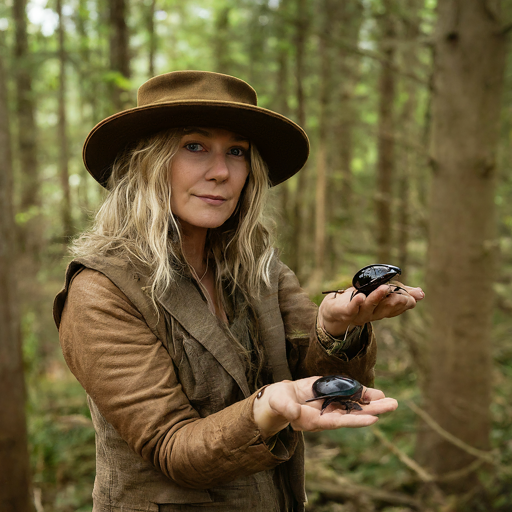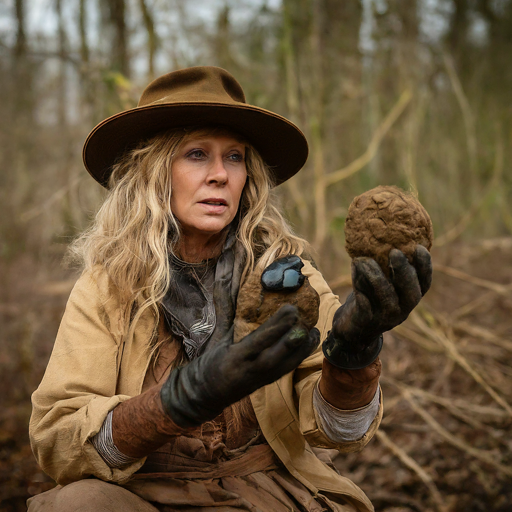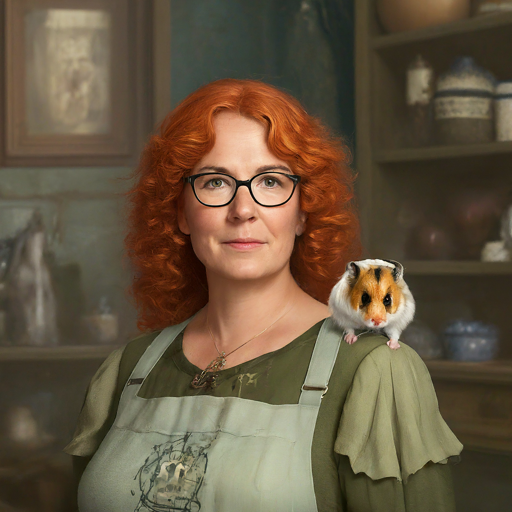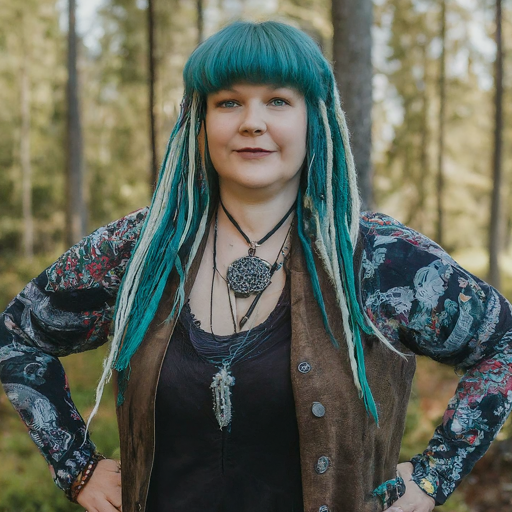-
AuthorSearch Results
-
February 15, 2024 at 8:44 pm #7376
In reply to: The Incense of the Quadrivium’s Mystiques
When they arrived at the hotel, the witches soon realized they were not the only uninvited guests here. With her keen sense of observation, Eris was the first to spot the traces left by an army of bedbugs. Tiny droppings on the mattresses and linen, blood stains left after the previous guests crushed the bugs while rolling in their bed. And the smell of dead rats was everywhere. Did they even have a cleaning staff here? When they complained, the hotel manager said: “Why do you care? Nobody comes here to sleep during carnival?”
Jeezel noticed the bug reference. Indeed, something was still bugging her after she had closed the portal. Something that should be obvious, yet was still an eyelash away from her grasp. But something more pressing was at stake. She posted pictures of the rooms and a reel of her disappointed face in front of the disaster.
“I was so happy to come to Rio for the first time. But the light is yellow and flickering. How can I show you how to do a proper Carnival makeup,” she said fluttering her eyelashes. As soon as the sound of a message well sent faded out, she started to receive support and love from her fans.
“Rio is not like that!”
“Somebody help.”
“2 bad! I’m on business trip. Wud hav luv to meet ya there!”
The sounds of likes and comments alerted Malové.
“What have you done! We were here incognito. Why don’t you go to the top of Jesus’s head and cast the Tempestarii Overture spell.”
“I could have! That would have gone viral. But we departed in such a hurry, I have left all my sapphires and stilettos in Limerick. You can’t cast that spell without them. Anyway, we don’t have to stay longer in that cesspit. One of my fans is abroad and has offered us to stay in his villa. Look at the pics! It looks as lush and gorgeous as a Jurassic park.”
Truella widened her eyes and said: “Saying that’s a big property would be an understatement. Roger would have loved to come with his new shovel.”
“Don’t even think of casting a second bilocation spell,” said Frigella. “You already look like deflated soufflé.”
“What’s the catch?” asked Eris with frown. “It looks like the kind of golden cage a king pin would own. But they have a pool.”
“He said we just have to feed the dwarf crocodiles while we are there,” said Jeezel nonplussed, looking at Truella whose eyes were ready to pop off of their sockets. Then she looked at Malové. “What do you say? You’re the eld…head witch of our coven.”
Malové’s eyebrow twitched. She was thinking fast. Little signs here and there, the orientation of the statues, the fountain, the placement of rocks that would look so random to a profane or a younger witch. Ancient earth magic? It was difficult to be sure with the framing of the pictures. Jeezel was swiping all the pictures her fan had sent her, hoping such glamour and mystery would melt Malové’s last reluctance.
“Omg! girls, we can’t refuse!” said Jeezel. “He’s got a bloat of pygmy hippos and a flamboyance of flamingos!”
As the drag witch continued to swipe the pictures, a prickle crept up Malové’s spine when she saw a familiar face amongst them.
“Look at him!” shouted Jeezel. “He’s a Gatsby with a spellbook.”
There were no more doubts for Malové about the kind of magic that had been used to build his empire. Augustus St Clair, a powerful witch indeed, and one whose invitation you couldn’t refuse especially since he now knew she was here. As one of the elders of the Rio’s witches community, she had danced the dance of rivals disguised as allies, a pas de deux filled with forced smiles and tight grips. Her words felt like needles scratching her lips when she uttered them: “Tell him we accept his invitation.”
The shouts of joy and disbelief coming from the witches couldn’t appease the memories that had resurfaced.
February 15, 2024 at 7:47 pm #7375In reply to: The Incense of the Quadrivium’s Mystiques
“The very image of a spy from a cheap novel. Perched behind his newspaper, peering through holes like a child with a telescope. He’s a creature of shadows, blending into the background, always watching, never seen. He thinks himself clever, but he’s as subtle as a cat in a fishbowl. He’s drawn to Frigella like a moth to a flame, but can’t shake off his ingrained caution. Intrigued yet wary, like a mouse sniffing a piece of cheese in a trap. He needs to make up his mind before his tail gets caught.”
“What’s on your mind, Needles?” Frigella inquired of her hedgehog familiar.
“Nothing,” replied the hedgehog cryptically, returning happily to his strawberry snack. “But you’ll soon find out…”

Cedric Spellbind found himself woefully unprepared for what was coming after the jump into the weird glowing vortex. On a hunch, he’d followed the enigmatic Miss O’Green. Something about her, her diaphaneous looks…
His wool tweed cap wasn’t the best attire for wherever he had jumped into. The damp smells, the warm humid air filled with electricity —something told him he wasn’t in Limerick any more,… but where.
The group Ms Frigella was with had moved swiftly, nonchalantly going in the streets after the boisterous tall figure with the black curly wig had made a string of light glow on the ground, evanescent trail they followed unhesitant to somewhere only them seemed to know.
He was struggling to keep the pace. At some point, the blue-haired one had turned suspiciously casting her glance, and he’d managed to dart in a nearby alley. They’d resumed their stroll, but she’d done something after that, some sort of dark magic that made their group seem to disappear in a fog, the sounds they made suddenly all muffled.
Accustomed to tracking witches, he’d discreetly put a findmystuff tracker on the bag. Wherever that bag would go, he would follow. He opted to let them proceed unhindered, for now.
He checked his phone. He couldn’t catch the signs in the streets during his shadowing. His phone had started buzzing as soon as he’d emerged from the vortex, so he was surely in another country. The SMS he’d received confirmed that hypothesis: he was in Brazil.
5 missed calls. His mother… He couldn’t call her back now, it would cost him a fortune, and his witch tracking wasn’t exactly paying the bills. She would hate him for it, but she would have to wait. Maybe a bit of worrying for him wasn’t bad. One could hope.
His last witch hunt hadn’t been the most successful. Bulgarian witches were fierce. To be honest, it had been a fiasco, and he was posted in Limerick as a consequence —on desk job only. He knew there were worse places to be, but he was missing the action of the field… He shouldn’t have followed these witches, but again, following orders had never been his strong suit.
February 15, 2024 at 11:04 am #7373In reply to: The Incense of the Quadrivium’s Mystiques
The disturbance had been felt in the bustling heart of Rio.
The warmth of the night had amplified the vibrant energy of the Carnival in Rio, a pulsating heart that reverberated through the city’s veins. But as the beat of samba drums echoed in the distance, a different rhythm was being played behind closed doors. Iemanjá, the head of the Umbanda clan and a pillar of strength in the Witches of the New World, recognized the tremors of another magick at play.
Gathering her coven under the silvery light of the crescent moon, they began the rhythmic dance of the macumba ritual. The air grew heavy, scented with copal and the salty tang of the ocean. In the center of their circle, a waterspout swirled, revealing in its shallow reflection the glow of a portal that emitted the icy chill of a Limerick dawn.
Piercing through the veil of secrecy, Iemanjá’s ethereal sight witnessed the foreign witches, led by the enigmatic Malové, who dared to encroach upon their territory without the required parchmentwork. And yet, their motives remained hidden within the vortex of desire and lust emanating from the Carnival.
A murmur of discontent rippled through the Umbanda clan. Mesmirah, her second, couldn’t stop herself shouting Sacrilégio! They were not ones to tolerate trespassers, let alone those who dared to siphon off energy from their sacred lands.
Silêncio! Iemanjá commanded the crowd. She’d recognized Malové from having attended and graduated the same MWA (Master of Witchcraft Administration), and she was aware of Malove’s little incense business; Malové didn’t strike her as someone to bypass the rules, some handed down through countless generations, binding together most witches across the world despite their varying practices.
She had to be mindful of the delicate balance between the Old World clans and the New. An unauthorized incursion could easily spark a conflict that would ripple through the witching worlds.
Just as the ocean waves respect the boundary of the shore, so must the witches respect the territories — an ancient pact carved in the pillars of the Old World. This blatant disregard by Malové and her coven was akin to scratching the surface of a simmering cauldron, threatening to disrupt the harmony that had been carefully cultivated.
As the revelation sunk in, Iemanjá knew they had to tread carefully. A confrontation would lead to a war bigger than themselves —yet, they couldn’t let this transgression slide. Their pride and the protection of their territory demanded action.
Mesmirah! she finally spoke You will take three witches with you, and investigate what business these Old World witches have in Rio. You will report to me.
Mesmirah nodded, understanding that she was not yet granted authority to investigate in an official capacity. Iemanja was acting surprisingly soft, and didn’t want the Elders to be informed yet, but had recognized action was needed. Mesmirah was confident she would easily find out what was happening, and maybe use that opportunity to her —their advantage. The game of power was on.
February 13, 2024 at 9:24 pm #7370In reply to: The Incense of the Quadrivium’s Mystiques
She knew she was being followed even before her familiar started to psst her about the dark haired cloaked stranger.
Eris couldn’t pinpoint precisely what drove her to leap headfirst into the swirling vortex. Perhaps it was a misplaced sense of duty —it was certainly not the sentiment of thrill that Malové had attempted to instill. It was probably the same habit that compelled her to eat the repulsive morsels off her plate first, working her way up to the more palatable fare.
Kirottu juoma, she muttered under her breath as she forced down the bitter potion Frigella had provided, intended to counteract the disorienting effects of the displacement spells within the vortex. Their abrupt arrival in the sultry heat of Rio caught them off guard, despite the stillness of the night.
“Would go down better with a dash of brandy” Truella said, wincing. She appeared on and off, and seemed to struggle to remain focused.
“I can’t believe it! Are you actually on a bilocating spell?” Malové asked reproachfully to Truella. “I thought it was obvious I needed your undivided attention!”
“Sorry,” Truella said after a moment of absence and a burp. “Was talking to Roger at the same time.” Then catching up with the remark, she shrugged and retorted “must have missed the fine print.”
Malové remained stoic like a serene swan above water, her mad paddling never perceptible. “No time to dawdle, we have to make preparations for the gathering of essence. “Jeezel! Are you listening?”
“Yes, M’am,… I mean Grand Hexmistress.”
The other witches looked at her like she’d blurted out something out of place. Malové chose to let it pass. “Quick now, you’re the one with the sigils to find us the perfect spot to set up our equipment.”
“Yes, yes! I’m on it!” Jeezel replied, so visibly distracted that her wig went askew by a millimeter without her noticing.
“Have you forgotten proper decorum in addressing the Head Witch? What’s happening?” Frigella drew Jeezel gently by the sleeve.
Jeezel’s eyes widened in mild panic: “I think I may have forgotten to close the portal.”
February 11, 2024 at 12:34 pm #7366In reply to: The Incense of the Quadrivium’s Mystiques
“Are we going down a sewer?” asked Truella as if you’d asked her to put her hand into dragon poop to see why they had diarrhoea. She was wearing the green blouse of a nurse. Jeezel’s thought the colour was almost a match with the witch’s face.
“Don’t be difficult,” said Frigella a bit annoyed. “You spend most of your free time in a hole as a hobby.” She was readjusting her purple blouse, which seemed to be bit too big for her.
“It’s my hole,” said Truella. “I know what’s in there. It’s got nothing to do with that murky miasma of decayed dreams and digested dinners piling up down there as a testimony of Limerick’s population’s contemplation of their puny lives on their pitiful thrones. And the stench, it cuts through the air, it would make a maggot gag. I tell you, certain portals are best left untraveled. I wonder why Malové has left you in charge of the portal.”
“We won’t go through the sewer,” said Jeezel. “It’s an ancient spell I got from my grand-mother Linda Pol from the time of her Time Travelling drag show. It creates a vortex impervious to any smell. If maggots gag it’ll be because they saw your panties.”
Truella, who had never learned how to hold her tongue, started to open her mouth when Malové arrived. She inspected every witch’s nurse attire and winced at Jeezel’s white blouse that made the tall witch look like one of those nightingale from the 50’s.
“Will you be able to breathe?” she asked. “We don’t want to be stuck here because you fainted before finishing your spell.”
“This is my natural silhouette, whispered Jeezel. The fabric is very stretchy. Anyway, I’m using sigils to cast this spell.”
Truella stopped her snort short when Malové glanced at her own blouse.
“As for you, your words are not the only thing you could iron out.”
Then she gave a nod of appreciation to Frigella and Eris. “Then we’re good to go.”
Jeezel started to draw lines and curves in space above and around the manhole, she looked like a peacock flaunting its feathers. Then she used her orange gloss to draw the one sigil around the manhole and invoked its name. Frigella who was seeing it performed for the first time had the impression Jeezel said “Fern” but she wouldn’t put her hand in a witch’s fire for it. The manhole cover shimmied and shook like it was coming to life. It lifted, hovering with all the grace of a duchess at high tea before sliding aside.
“Et voilà,” said Jeezel with glitter in her eyes. “Who’s first?”
Eris, intrigued by the vortex of glowing and sparkling with all the magical energy coursing through it, jumped right in, not waiting for anyone to answer.
February 11, 2024 at 10:57 am #7365In reply to: The Incense of the Quadrivium’s Mystiques
They had to wait for Finnlee to diligently do the first room, her morning routine starting with the hall.
Malové knew better for her effects than to try to speak in the middle of all that cleaning. Luckily for them, Finnlee was anything but quick and efficient, so it didn’t take long for the sound of the hoover and the slurping noises of the mopping stick to move to another room, resorbing in the background.While Malové had made herself comfortable in a neon green armchair with a peppermint tea, the other witches had used the noise coverage to whisper to each other concerns and hypothesis. “So what is this about?…”
Malové relished in the waiting obviously. After the silence had come back, save from a few clangs and humming cursing sounds in the background, she started to expose the reason they were all here.
In her most dramatic fashion, Malové began, “Ladies, we’re off to Rio. The Carnival awaits. Get your sequins, feathers, and your most daring dance moves ready.”
“But why?” Truella asked, her eyes widening. “I mean, I love a good party, but why Rio?”
“Because, dear Truella,” Malové smirked, “where else can we find such a delicious blend of desire, passion, and pure, unadulterated lust?”
Jeezel piped in, “You mean we’re going there to… collect?”
“Oh, we’re going to do more than just collect,” Malové replied, an unruly gleam in her eyes. “We’re going to distill it, bottle it, and use it to create a new line of incense and smokes. These will not just spice up the lives of those around us, but aid in procreation. After all, the world does need a bit of a… boost.”
“A bit risqué, don’t you think?” Frigella said, raising an eyebrow.
“Darling, risqué is my middle name,” Malové retorted. “Now, pack your bags. The Carnival won’t wait for us, and we have some serious samba-ing to do.”
Eris, who had been silent till now, finally spoke, “This could either be the most ingenious plan you’ve ever concocted, or the most disastrous. You surely have heard about the dengue outbreaks?”
“Well,” Malové smiled, “of course I have. That’s why we’ll have the perfect cover. We will be blending in as nurses part of the relief effort locally. And anyway, there’s only one way to find out. To Rio and the Sambadrome, my witches!”
The quartet of witches looked at each other, clearly not unhappy to leave behind for some time the chill of Limerick for the wild heat of Rio, the promise of adventure twinkling in their eyes of some.
February 11, 2024 at 10:32 am #7364In reply to: The Incense of the Quadrivium’s Mystiques
“Witches, assemble!” It was hard for Malové to forget the theatrics, even in presence of a limited number of persons.
The three witches had come in a hurry, summoned for some of them by a loud howler in the early light. Admittedly, Malové had to compensate for the usual tardiness of some, and her impeccable spells had been calling for the trio at just the right time for each to arrive precisely to the Quadrivium’s Headquarter in less than a minute’s space one from the other.
“Unbelievable” Frigella had muttered when she saw Truella already there.
“Hoy, don’t get your knickers in a twist Love, I’ve been called to that meeting only two days ago!”
Frigella didn’t have time to retort with a snark that she’d been summoned less than fifteen minutes before, as another popping sound and a flush indicated the arrival of Eris from the Quadrivium’s Emporium backdoor in the lady’s room.
“And where is Jeezel?” Truella wondered. “I haven’t seen her yet.”
“Oh, you know, there’s no accounting for wig time preparation even with Malové superb spells skills” Eris said pragmatically.
“I wouldn’t say that.” The voice of Malové, stern but not devoid of warmth, signaled the end of the chatty banter. “She was doing some chores for me, but she’ll be back in a second.” She clapped her hands elegantly, each hand barely touching the other, yet ripples of powerful energies resounded throughout the space.
The doors flung open, revealing Jeezel in a gorgeous golden fitting ensemble, the chiffon kerchief she had before to do her chores replaced by a subtly glittering tiara standing proud on the loveliest curly wig of luscious magpie dark hair reflecting a striking metallic blue in their shine.
Jeezel, who had been secretly crying over the punishment touched her cheeks for signs of blurred cracked mascara, but instead, she could feel her cheeks were delicately powdered, her eyes contoured to perfection.
“What?…” she for once couldn’t voice her emotions.
“Silly goose,” Malové smiled in a hard to decipher rictus. “You have forgotten the evil witch and the fairy godmother are all part of the same cabal. Now,” and she turned intently to the other assembled witches.
“Are we getting punished too?” Asked Truella who couldn’t refrain to hide her rebellious nature “I won’t…”
Before she could say more, Malové raised her hand and said “Enough with this punishment nonsense. Even that foul-mouthed Finnlee with her down-to-earth mores knows that there is nothing like a little cleaning to clear up the space.”
A sigh of relief from the four friends. So if punishment wasn’t in order, what was it about?
“So where was I? It’s going to get me a whole new comment to get to where I…” She started to get flustered with exasperation from all the interruptions. The four witches were silent except for long agitated side glances at each other.
That’s when the door bell started to ring relentlessly. She thought to let it pass, probably a delivery person for the staff. But it wasn’t stopping.
“What is it?” her voice as honey-coated as the raspy tongue of a feral hellcat.
“It’s Finnlee, M’am Witch, erm, HeadTwitch. I forgot my keys, open the door if you don’t want this place to go to more waste. Mark my words. So much staff has come and gone, it’s a miracle I’m still here with …”
Malové rolled her eyes, and flipped her hands in a savant motion, opening the gates remotely for the cursing cleaning lady. She was right, one couldn’t get the staff these days. And there was nothing like a good solid floor scrubbing, no magic involved but elbow grease. Magic rarely stuck enough, and honestly, it would be such a waste of energy.
February 11, 2024 at 9:32 am #7362In reply to: The Incense of the Quadrivium’s Mystiques
“Is he ready yet?” Echo the familiar sprite was waiting patiently, in the middle of Eris’ altar, surrounded by a delicate pattern of magical items.
“Quiet, I need to concentrate.” Eris was close to finishing the spell, and needed her familiar’s assistance. The ink was drying on the pages of her grimoire, and she took a breathe; the words were sufficiently inspired, the right intention and blessings would ensure they would be potent.
After the proper offering was made to the Elders and the nearby tree spirits, she uttered the words, inspired by her familiar’s presence who was helping her to concentrate the permeating energies:
“Silmiä avaava digitaalinen tila, Luoja Lönnrotin. Vie meidät kaukaisille maailmoille, jossa tarinat elävät ja hengittävät koodien keskellä.”
(🗣️Sound 🎶 ). “Eye-opening digital space, Creator Lönnrotin. Takes us to distant worlds where stories live and breathe in the midst of codes.”
“Is it done?” Eris asked Echo, who had flickered for a moment, hinting at a magical energy exchange in progress.
“I think it is,” it jumped from the altar to her shoulder. “How are you going to call it?”
“Are you getting jealous Whisp?” she smiled, while her pixie took the shape of an eye rolling teddy bear.
She started to clean the space, rolled and tied her blue braided hair in a bun. “I’ll call him Elias, simply. Inspired by Elias Lönnrot, to draw on his greatest creations, and fit for the digital age. We can all use some ancient wisdom.”
“Simple… and effective I guess. And you’ve got a task in mind for him already?”
“Yes, but I’m afraid it’ll have to wait, we have to hurry, Malové has called for an extraordinary session, and I can’t miss it.”
February 11, 2024 at 9:06 am #7361In reply to: The Incense of the Quadrivium’s Mystiques
Truella had already left for that monkey hunt in the Mediterranean. Eris had to go back before nightfall, which was quite early at this time of year as she had chosen to live in such a remote place in the midst of a frozen forest. Jeezel only thought it romantic because of the icicles that would form on your eyelashes and brows, making you the perfect avatar for the Snow Queen musical. And Frigella… She said she was tired but from the sight of her aura, she undoubtedly was onto something fishy.
Jeezel looked at her dress. Once a divine creation, it has turned into a disaster. Irremediably stained with soot, it’s foul smell would make any dragon lose their appetite. She felt a mix of sadness and guilt for all the murex that gave their shells for that unique shade of purple she was so proud of.
She wasn’t sure even Teddy Steambolt could muster his magic to save the divine creation. She imagined his eyes widen as saucers when she entered his Palace of Pristine with the lifeless garment in her arms. He would most certainly swoon and gasp at the same time.
“Oh, The tragedy!” he would wail, his high-pitched lament resonating in the cathedral ceiling of his atelier of cleanliness. “What calamity hath befallen this exquisite creation?”
“Teddy, dear,” she would say, “It was indeed a tragedy. I lost seven of my nails and my hair was ruined. You’re the alchemist of cleanliness, you’re my only hope for a miracle.”
And he would take her dress and perform his magic from which it would emerge reborn, and all those murex wouldn’t have lost their home for nothing.
She was about to follow the others when Malové reminded her: “Aren’t you forgetting something?”
A broom and a bucket of black soap were floating on her right.
Her sigh would have made a blue whale blush with envy. Her role tonight would not be the Snow Queen, but Cinderella, another of her favourite diva.
February 9, 2024 at 11:44 am #7360In reply to: The Incense of the Quadrivium’s Mystiques
Trying not to smile too broadly, Truella was delighted with Malove’s latest idea. An inveterate and unrepentant smoker, she had often wondered what the hysteria about cigarette smoke was all about. It seemed as ludicrous as the Victorian fashion for hiding immodest table and piano legs with voluminous paisley shawls while sending children up chimneys to clean them. Those who railed against tobacco smoke filled their rooms with the noxious fumes of incense or toxic “air fresheners”, their fridges with smoked bacon and smoked salmon, delighted in “real fires” with nostalgic wisps of smoke curling from country cottage chimneys, and sitting around a smoking barbecue or campfire. Humans had lived in smokey hovels and caves since the beginning of time.
Frigella noticed Truella smirking and shook her head, tutting. With a devilishly wide grin, Truella whispered, “Meet me in the pub afterwards, need to talk.”
“Perhaps we can count on your full and undivided participation for once, Truella,” Malove said, who hadn’t missed anything. “With your penchant for filling public spaces with smoke, this mission will no doubt appeal to you greatly.”
“Indeed,” she replied, endeavouring to look demure and obedient.
February 7, 2024 at 9:41 pm #7359In reply to: The Incense of the Quadrivium’s Mystiques
Head witch Malové must have been used to it, for having seen that magic at play a number of times… there was nothing like the strange serendipity of chaos.
After the smoke had finally cleared, Malové couldn’t bear to stand amidst the wreckage of their once impeccably arranged ritual space. She looked at the mess, the sheer ridiculousness of it all, and decided to go for a brisk walk in the streets of Limerick. The light drizzle and sharp sting of the winter air brought back some pink to her pale face. To cover her perfectly coiffed head, he wrapped her shawl, black and shiny as a dung beetle, and moved swiftly cutting through the crowds effortlessly, parting the human congeries like Moses did the Red Sea. She was never unnoticed; her tall lean silhouette, accentuated by the sleek robe noire, the vertigo of her stiletto, the cheekbones so sharp they could kill — there was nothing common about her frame; and after the years, and all the side glances, she’d clearly lost practice on how to give a damn.
It was at the turn of a dark corner illuminated by the neon sign of a Chinese local eatery under which the delivery guy was having a break that the synchronicity stuck her. A slow smirk tugged at the corners of her mouth. From chaos, clarity had emerged.
Vaping, hookah, e-cigarettes —all the rage among the mindless masses. And there, in the plumes of artificially flavoured smoke, was their opportunity. A new way to infiltrate the consciousness of the people, to subtly attune their energies and guide them towards emotional management —or at the very least, less stupidity.
She imagined their Incense —the sacred concoctions of herbs and essences, entwined with potent spells— being drawn into eager lungs, seeping into the bloodstream, entangling with the very atoms of their being, a sweet balm better than the usual deleterious micro-plastics. The witches wouldn’t just be casting spells; they’d be weaving their magic into the fabric of life itself, one puff at a time.
The more she thought about it, the brighter the idea seemed. It was audacious, unconventional, bordering on scandalous. A few days ago maybe, she would have balked at the mere thought. But desperate times called for this… elegant, simply perfect. For the witches of the Quadrivium Coven of Mystiques, she had even less doubts or concerns about warming them up to such iconoclastic idea. She knew a group of them, those black sheep never to shy away from a little controversy. And if they could use the vaping trend to spread their influence, then why not? Enough with surviving on the Chinese New Year only, the whole world was ripe for extended incensing.
February 6, 2024 at 11:02 pm #7355In reply to: Smoke Signals: Arcanas of the Quadrivium’s incense
Interpretations
Truella



Frigella



Eris

Jeezel (Jeeze the hair!)


Malové



Other characters
Fringella (and not Frigella, who’s blonde like Tilda)


Specializing in elemental and herbal magic, Fringella has an intimate connection with the natural world. She is an adept healer and potion-maker, often creating remedies that blend traditional herbalism with powerful enchantments. Her signature spells often involve fire and earth, reflecting her passionate and grounded nature.
While she shares a name with Frigella, the two are quite different in both temperament and approach. Their interactions are marked by a mutual respect, though Fringella’s fiery disposition often contrasts sharply with Frigella’s more traditionalist and meticulous nature.
Eris’ aunt: Amara (
 )
)Amara, a woman of gentle yet resolute nature, provided Eris with a grounded upbringing amidst a world filled with arcane mysteries. Despite lacking magical abilities, Amara’s wisdom and nurturing spirit played a crucial role in shaping Eris’s character and guiding her through the complexities of her witch heritage. Amara’s home was a sanctuary where the mundane and the mystical coexisted harmoniously, offering Eris a unique perspective on the balance between everyday life and the magical realm.

 February 6, 2024 at 8:23 am #7354
February 6, 2024 at 8:23 am #7354In reply to: The Incense of the Quadrivium’s Mystiques
By the time night fell over the Mediterranean village, the monkeys were still on the loose, having defied all attempts to capture them. Truella decided to go and see for herself, having noticed that all the photographs in the news were rubbish. She knew she could do better than that. The authorities were supposedly trying to capture them, but all she’d seen from the photos were the police standing in the narrow streets looking baffled, staring up at the primates scampering all over the rooftops and swinging from balcony to balcony.
Where had all the monkeys come from? Was it some kind of trick? It was, after all, Carnaval season, and tricks and buffoonery were rife. And it would be a nice outting for Roger, before she set him to work. He’d been very quiet since his arrival that morning, probably shy, Truella thought, and perhaps jetlagged.
Grabbing her camera and a bunch of bananas, they set off towards the coast. Truella attempted to engage Roger in conversation, but he just smiled sheepishly and mumbled unitelligably by way of response. Inwardly Truella rolled her eyes and wondered what she’d got herself into. Still, a silent brawny helper was better than no help at all.
Parking the car was uncharacteristially easy and they made their way on foot to the hodge podge row of beach shanties and fishermens cottages by the sea where the crowd had gathered to watch the monkeys antics. Despite the full moon, the monkeys were hidden in the shadows, until every now and then the streetlights spotlit them as they leaped from roof to roof. A conveniently situated bar was open with tables and chairs on the pavement, and Truella and Roger sat down and ordered drinks and peanuts. Within moments Roger had eaten all the peanuts, so Truella turned to catch the waiters eye to order more. He was serving a chubby pale woman in tartan bermuda shorts, surely a tourist, Truella deduced, as it was not yet shorts weather for the locals.
“Whirling ‘n’ twirling a muckle puff o’ rowk,” the woman was saying to the waiter, to which he replied “Que?”, and Truella gasped, grabbing Rogers forearm. “Oh my god, it’s Griselda. What is that Scottish bogwitch doing down here?”
“Ye’ll dae as ah say…”
“Oh no he won’t,” Truella shouted across the terrace. “Grizel! Griselda MacSmotheringhampton! We don’t do that here!” To the confused waiter she said, ” I’ll pay for it, put it on my bill. Don’t listen to her, she’s as mad as a box of frogs.”
And then it dawned on her. She glared at Griselda and hissed, “This is your doing, isn’t it? All these monkeys, it’s your doing, isn’t it?”
Griselda smirked. “And what are ye gooin tae do aboot it?”
February 5, 2024 at 8:08 pm #7350In reply to: The Incense of the Quadrivium’s Mystiques
Eris did portal to be in person for the last Ritual. After all, Smoke Testing for incense making was the reverse expectation of what it meant in programming. You plug in a new board and turn on the power. If you see smoke coming from the board, turn off the power. You don’t have to do any more testing. But for witches, it just meant success. This one however revealed itself to be so glorious, she would have regretted sorely if she’d missed it.
“Someone tried to jinx my blog with black magic emojis! Quick, give me a Nokia!” Jeezel sharp cry was the innocent trigger that dominoed the whole ceremony into mayhem. With her clumsy hand gestures, she inadvertently elbowed Frigella as she was carefully counting the last drops of the resin, which spilled over to the nearby Bunsen burner.
From there, the sweet symphony of disaster that unfolded in the sanctified chamber of the coven could have been put to a choral version of Tchaikovsky’s Overture 1812, with climactic volley of cannon fire, ringing chimes, and brass fanfare. Only with smoke as sound effects.
In the ensuing chaos of the Fourth Rite, everything became quickly shrouded in a thick, billowing smoke, an unintended byproduct of the smoke test gone wildly awry. Truella, in her attempts to salvage the ceremony, darted through the room, a scorched piece of fabric clutched in her hand—her delicate pashmina shawl that did more fanning than smothering and now more charcoal than its original vibrant hue. Her expression teetered between horror and disbelief as she lamented her once-prized possession, now reduced to ashes.
Jeezel, ever the optimist, quickly came back to her senses choosing to find humor if not opportunity amidst disaster. Like a true diva emerging from the smoke effects, she held up a singed twig adorned with the remains of decorative leaves and announced with a wide grin, “Behold, the perfect accessory for the Autumn Pageant!” Her voice was muffled by the smog, her figure obscured save for the intermittent glint of her eyes as she wove through the smoke, brandishing the charred twig like a parade marshal’s baton.
Meanwhile, Eris was caught in a frenetic ballet, attempting to corral the smoke with sweeps of her arms and ancient spells, as if the very air could be tamed by her whims. Her efforts, while noble, only served to create an odd wind pattern that whirled papers and loose items into a miniature cyclone of confusion.
At the epicenter of the pandemonium stood Malové, the High Witch, her composure as livid as the flames that had sparked the debacle. Her normally unflappable demeanor crumbled as she surveyed the disarray, her voice rising above the cacophony, “Witches, have you mistaken this sacred rite for a comedy of errors?” Her words cut through the haze, sharp and commanding.
Frigella, caught off-guard by the commotion, scrambled to quell the smoky serpent that had coiled throughout the room. With a flick of her wand, she directed gusts of fresh air towards the smoke, but in her haste, the spell went askew, further fanning the chaos as parchments and ritual tools spun through the air like leaves in a storm.
All the witches assembled, not knowing how to respond, tried to grapple with the havoc.
There, in the mist of misadventure, the Fourth Rite of 2024 would be one for the annals, a tale to be told with a mix of chagrin and mirth for ages to come. And though Malové’s patience was tried, even the High Witch couldn’t deny the comedic spectacle that unfurled before her—a spectacle that would surely need to be remedied.
January 31, 2024 at 4:51 pm #7329In reply to: The Incense of the Quadrivium’s Mystiques
The soft candle light on the altar created moving patterns on the walls draped with velvets and satins. The boudoir was the sanctuary where Jeezel weaved her magic. The patterns on the tapestries changed with her mood, and that night they were a blend of light and dark, electricity made them crackle like lightning in a mid afternoon summer storm.
The altar was a beautifully crafted mahogany table with each legs like a spindle from Sleeping Beauty’s own spinning wheel, but there was no sleeping done here. On her left, her vanity with her collection of wigs, each one a masterpiece styled to perfection, in every shade you could imagine. Tonight, she had chosen the red one. It was a fiery cascade of passion and power, the kind of red that stops traffic. Jeezel needed the confidence and boldness imbued in it to cast the potent Concordia spell.
The air was thick with the perfume of white sage. Lumina, Jeezel’s nine tailed fox familiar, was curled-up on a couch adorned with mystical silver runes pulsating with magic, her muzzle buried in the fur of her nine tails. Her eyes half closed, she was observing Jeezel’s preparation on the altar. The witch had lit a magical fire to heat a cauldron that’s seen more spells than a dictionary.
Jeezel had carefully selected a playlist as harmonious and uplifting as the spell itself, to make a symphony of sounds that would weave together like the most exquisite lace front on a show-stopping wig. She wanted it to be an auditory journey to the highest peaks of harmony that would support her during the casting.
As the precious moon water began to simmer, Jeezel creased the rose petals and the lavender in her hands before she delicately dropped them in the cauldron. The scent rose to her nose and she stirred clockwise with a wand made of the finest willow, while invoking thoughts of unity and shared purpose. The jittery patterns on the walls started to form temporary clusters. A change of colour in the liquid informed the witch it was time to add a drizzle of honey. Jeezel watched as it swirled into the potion, casting a golden glow that promised to mend fences and build bridges. The walls were full of harmonious ripples undulating gently in a soothing manner.
Once the honey was completely melted, Jeezel dropped in an amethyst crystal, whose radiating power would purify the concoction. The potion started to bubble and the glow on the tapestries turned an ugly dark red. Jeezel frowned, wondering if she had done something wrong.
“Stay focused,” said the fox in a brisk voice. “Good. The team energy is fighting back. Plant your stiletto heels firmly into the catwalk, and remember the pageant.”
The familiar’s tawny eyes glowed and the music changed to the emergency song. Jeezel felt an infusion of warm and steady energy from Lumina and started humming in sync with The Ride of the Valkyries. She stirred and chanted, every gesture filled with fiery confidence. The walls glowed darker and the potion hissed. But in the end, it was tamed. The original playlist had resumed to the grand finale. A gentle yet powerful orchestral swell that encapsulated the essence of unity and understanding, wrapping the boudoir and the potion in a sonic embrace that would banish drama and pettiness to the back of the chorus.
Jeezel released the dove feather into the brew, then finished with a sprinkle of glitter with a flourish. And it was done.
“Was the glitter necessary?” asked Lumina.
“Why not? It can’t do any harm.”
The fox jumped from the couch and looked at the potion.
“It’s sparkling like the twinkle in your eye when you hit the stage. It’s ready. Well done.”
Jeezel strained it with grace and poured it into the most fabulous vial she could find, and she sealed it with a kiss.

Jeezel opened Flick Flock and started typing a message to Roland.
The potion is ready. I’m sending it to you through the usual way.
[…]
As you use the potion, you’ll have to perform a kind of team building ritual that will help channel the potion’s power and bring your team together like sequins on a gown, darling.
Fist, dim the lights and set the stage with a circle of candles. Then gather around in the circle with your team, each of you holding a small vial of the potion. Next, take turns sharing something positive, a compliment or an expression of gratitude about the person to your left. It’s about building up that positive energy, getting the good vibes flowing like champagne at a gala.
Once the air is thick with love and camaraderie, each team member will add a drop of the Concordia potion to a communal bowl placed in the center of the circle as a symbol of unity, like a magical melting pot of harmony and shared intentions.
With the power of the potion pooling together, join hands (even if they’re not the touchy-feely types) and my familiar will guide you in an enchanting and rhythmic chant.
Finally with a climactic “clink” of glass of crystal, you’ll all seal the deal, the potion will be activated, and the spell cast.
I can affirm you, your team will be tighter than my corset after Thanksgiving dinner, ready to slay the day with peace and productivity.
Let’s get this done. And don’t forget to add a testimony and click the thumb up.
xoxox Jeezel.
January 30, 2024 at 8:32 pm #7327In reply to: The Incense of the Quadrivium’s Mystiques
Her garden, oh, it’s a living canvas of her passions – a wild, untamed thing with bursts of vibrant color and the heady scent of jasmine and orange blossoms that intoxicate the senses. But beneath its beauty lies a secret, a whisper of the past that Truella, with her insatiable curiosity and archeological fervor, has unearthed: the remnants of an Andalucian Roman villa.
Imagine the thrill, the pure, unadulterated bliss of discovery, as her fingers brush away centuries of soil to reveal ornate mosaics, fragments of pottery that once held the finest olive oil, and coins stamped with the visages of long-forgotten emperors. Each artifact, a breadcrumb leading her deeper into the enigma of history.

But, of course, Roger, our simple-minded gardener with not a thought in his head beyond petunias and pruning, has proven to be surprisingly useful. His brawn has unearthed more than his fair share of antiquity, even if he hasn’t the faintest idea of its significance. “Look, Truella, I’ve found another shiny rock,” he says, and I, Lisia Tattius, can only chuckle at the delightful irony.
Truella’s Andalusian escapades could fill volumes, and perhaps they shall. There’s something deliciously appealing about a woman alone, grappling with the very fabric of time amongst the ruins of an empire.
Truella couldn’t see any benefit in rewriting all that and thanked Lisia very much, although she did wonder who Roger was. A gardener though! Someone to carry all those buckets of dirt hither and thither. Someone to dig the next overburden!
Was there a spell for dissolving an overburden, she wondered? Inspired, she could already imagine how easy it would be to convince the team that this spell would have beneficial and universal applications.
Truella was pleased to see the mention of mosaics, the very thing she wanted to find. She planned to make a mosaic detector wand. But Truella didn’t want Lisia telling her where the mosaic was because it would spoil the whole thing. Mentioning mosaics, however, as already found, was the perfectly measured tincture of encouragement. A bit like spells in general really. Tricky business, getting them right.
January 30, 2024 at 10:45 am #7326In reply to: The Incense of the Quadrivium’s Mystiques
Jeezel pushed open the door of her favourite florist The Enchanted Garden. The clear sound of wind chimes welcomed her. An ever changing melody atuned to earth and water. Flucinda was at the counter serving another client. She might not be of the flamboyant kind but she knew her way with flowers. Her shop was a botanical wonderland, a cornucopia of color and fragrance that would make Mother Nature herself green with envy. The witch took a moment to breath in. It helped her relax a little.
“Jeezel! How are you dear?” asked Flucinda as the client left with his arms full of red roses. “You’re glowing as always.”
The witch blushed just a little at the compliment. Flucinda’s dark brown eyes were as sharp as those of a silent observation assassin. They darted swiflty over Jeezel’s silhouette, taking mental notes, absorbing the energy, the secrets, the silent dialogues.
“What do you need today?” she asked.
“Petals of a white rose, lavender buds and mint. And a few other things.” She said, handing the florist a list.
“Why don’t you wait in the heart of the Enchanted Garden while I’m preparing all that for you. Water is boiled, I’ll bring you some freshly brewed herbal tea.”
Jeezel felt grateful to her friend. She sat on an ornate stone bench and enjoyed the soft serenade of trickling water from a sparkling fountain and the symphony of scents — delicate jasmine, heady rose, spicy carnation and a hint of sweet lily. It helped sooth her anxiety. She had received a request on Sponsoreons by one of her fans and loyal customer. Apparently the last full moon had pulled the thread on the tightly knit sweater of camaraderie at this poor soul’s job. There appeared to be more drama in that workplace than at at drag queen bingo night when the last sequin-studded handbag is on the line, and the usual symphony of productivity has turned into a cacophony of cattiness and pettiness. Even the smallest of issues were being blown up like a lip injection gone rogue!
She had the perfect spell for it: Concordia. Used to bring harmony and peace, smoothing over the ruffled feathers and frayed edges. It was the divine choice for that case. However, such a potent spell was not to be taken lightly. If it was not crafted with precision, intent and a touch of flair, things could go haywire faster than a wig snatch in a lip-synch battle.
“Here you go,” said Flucinda as she put the silver tray on a smooth rock at the edge of the fountain.
“Wow! It’s fabulous,” said Jeezel.
The teapot was a glamour, as opulent as a bejewelled crown. The steam rising from its beak carried whispers of secrets and spells, bringing out memories of rumours swirling around a backstage pageant. It was in another life.
“Do I smell chamomile, lavender and valerian root?”
“Yes.”
Flucinda poured generously the yellow brew into an intricately carved white porcelain cup. Then added in a smidgeon of honey.
“I know you like it sweet,” she said to the witch before adding a sprinkle of edible silver stars. “Take the time you need. Everything will be at the counter when you’re ready to go.”
“Thanks Flucinda,” said Jeezel with a smile.
She took a first sip. It felt like a warm hug in a cup from a dear friend who knows just what you need. And she noticed a secret ingredient: a twist of lemon balm that gave the brew a citrusy zing. With every following sip, Jeezel felt the anxiety melting away like last season’s contour, leaving her ready to face the spellcasting with vigor and vim.
January 30, 2024 at 1:42 am #7324In reply to: The Incense of the Quadrivium’s Mystiques
“And that, my Dear Reader, is why, even to this day, a traffic cone is called a witches hat.”
It was the boy’s favourite bed-time story and Frigella had read it so many times she knew it nearly by heart. She twisted her neck so she could look down on the child; his breathing was soft, the bedside light illuminated long white lashes resting on chubby cheeks. Slowly… silently, she closed the book, switched off the night lamp and edged herself from the bed. She was very keen to log on to the Ritual and see what progress, if any, Eris had made.
The encounter with Truella and Jeezel that afternoon down at the Cabbage had disturbed her. It was not like them … Truella pouting and mutinous, Jeezel swaggering in so full of her own self-importance. And herself! Blushing and snorting and carrying on for no reason when it was her very nature to be composed. They had always worked as a team, the four of them; it was their strength.
Was some powerful magic afoot that had got through their protection? Perhaps Eris had found something. Her nose twitched and she realised she could still smell it, a pungent uneasiness. Like stale smoke.
“Aunt Friggy?”
She sighed. Her brother had made her promise not to use magic on the child but surely just a wee sprinkle of moon dust couldn’t hurt?
“Yes Conor?”
“Are witches true?”
She sat down on the bed.
“What does your Daddy say?” She stroked the child’s yellow-blond hair. Silky, like her own. He looked more like her than he did his own parents with his alabaster skin and eyes that changed colour like the sea. Always watching he was too, as though he was looking to the very heart of a matter. Just like herself. She was sure he had inherited the gift but Lorcon was having none of that nonsense and had told her so in no uncertain terms. The boy would suffer for it in time though. Just like she had when it had been denied.
“He said Conor don’t be so daft.”
Of course he did. Lorcon clung frantically to his normal life with his normal wife. Tonight she was baby-sitting Conor while they went on a normal date night. Still, she should not be so hard on Lorcon; it was a strange upbringing they’d had themselves.
She kissed the boy’s forehead and breathed deeply. The sweet scent of night jasmin washed over her. At least she’d be there for Conor. The thought consoled her.
“Shall I leave the light on for you, Poppet?”
January 29, 2024 at 10:59 pm #7323In reply to: The Incense of the Quadrivium’s Mystiques
The Four Rites opening the new year were done in a sequence, each followed by a day’s gap, until the final Ritual.
They were considered to open the gates to the realm of truth and ultimate freedom.
The first one, which Echo had noticed anomalies for, was about Self control. Eris was poring over the data, but none seemed to make sense. Her intuition was telling her something, but she couldn’t correlate any of it with what came out of the first step of the Incense making process. The collection of ingredients seemed correct, the origins clear.Yet, something wasn’t quite right.
The first one would be followed by tomorrow’s spell for Spirit of Enquiry. That’s when they could select the most proper ingredient, focusing their collective energies and inner eyes to what the collective needed to work on.
The last two ones were Contentment, where the ingredients were ground in fine powder, and finally of Good Company, where the powders were blended with resin and heated for the final tests.
Probably Eris would have to go to the HQuad tomorrow, physically for once to check on the process more closely. She waved her blue-green hair, her studded nose frowning at the perspective to have to check-in with the crowd of people. At least, commuting couldn’t be more simple. She would just have to turn the knob of her kitchen door in the opposite direction, wave her hand, until the door frame glowed briefly, and the door would simply open into the main hall of the Quadrivium Emporium ladies’ room.
But for tonight, they had a movie’s night planned with Thorsten.
January 28, 2024 at 3:20 pm #7319In reply to: The Incense of the Quadrivium’s Mystiques
Eris, logged off the Ritual, and stretched her long legs. That pandemic had brought them more work than ever, a new brand of Incense called “Vaxations” which they’d produced in record time, but of the little compensations for that harrowing time was the allowance to HFH (a.k.a Hex-From-Home). The Classical tenants of the Faith were missing quite a few of the modernities of the current world, and despite they’d been accounts of remote hexing from as long as the ages stretched, the Quadrivium Policies were quite clear you had to clock-in physically. That is, until the pandemic brought mayhem unto their clientèle, and rules had to be amended.
Eris was short for Ætheris, her formal witch name, which sounded much more airy than she’d liked. Eris, like the Goddess of Discord, well, that was more like her.
If she had to put her biography on the website of the Quadrivium Emporium it would read something like this:
Eris, the tech-savvy witch of discord, remains an enigma to most. She thrives in chaos, has a knack for bending technology to her will, and is pioneering a new branch of the Coven’s operations.
Technology had always been the eternal foe of Magic. As if everything explained by science somehow took away something off the realm of Magic. It was neither true, nor that simple, she believed. For one, she loved to blend the two (as most witches did, unwittingly).
Her familiar, Echo, was a proof of that. Echo wasn’t a tangible creature. Instead, Eris has somehow managed to summon an invisible digital sprite. This ethereal entity, capable of interfacing with any electronic device, was an invaluable asset to Eris’s technological endeavors.
Malové, their Head Witch CEO, had tasked her to launch a new branch, and given her some means to do so. Her intentions were rather unclear, but Eris had won her over when she showed her the parallels of Incense magic and Social Media.
Maybe that year, she would be keen to try and enhance their yearly Incense with some tech intelligence. Truth was, most of the artificial lives had been failures so far. Only Echo somehow turned out fine. One of a kind.“Echo,” she called, while a glowing blue sigil appeared in mid-air. “When you’re done with the latest…”
“Eris, sorry for interjecting, but you need to hear about this.”
She was too surprised to be mad. “What’s the matter?”
“Quality control on the first Ritual. It’s pointing out to some anomalies.”
-
AuthorSearch Results